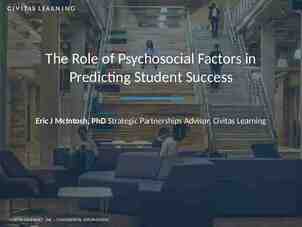CSI 5387: Concept Learning Systems / Machine Learning
15 Slides283.50 KB
CSI 5387: Concept Learning Systems / Machine Learning Instructor: Nathalie Japkowicz e-mail: [email protected] Objectives of the Course and Preliminaries 1
Some Information Instructor: Dr. Nathalie Japkowicz Office: SITE 5-029 Phone Number: 562-5800 x 6693 (don’t rely on it!) E-mail: [email protected] (best way to contact me!) Office Hours: Mondays, 2:30pm-4:30pm Extra Seminars: TAMALE Seminars, Wednesdays, 2:30pm-4pm (invited talks on Machine Learning and Natural Language Processing) See: http://www.tamale.uottawa.ca for talk announcements Write to Jelber Sayyad ([email protected]) to receive all announcements by e-mail (strongly suggested) 2
Machine Learning: A Case Study Malfunctioning gearboxes have been the cause for CH-46 US Navy helicopters to crash. Although gearbox malfunctions can be diagnosed by a mechanic prior to a helicopter’s take off, what if a malfunction occurs while in-flight, when it is impossible for a human to detect? Machine Learning was shown to be useful in this domain and thus to have the potential of saving human lives! 3
How did it Work? Consider the following common situation: You are in your car, speeding away, when you suddenly hear a “funny” noise. To prevent an accident, you slow down, and either stop the car or bring it to the nearest garage. The in-flight helicopter gearbox fault monitoring system was designed following the same idea. The difference, however, is that many gearbox malfunction cannot be heard by humans and must be monitored by a machine. 4
So, Where’s the Learning? Imagine that, instead of driving your good old battered car, you were asked to drive this truck: Would you know a “funny” noise from a “normal” one? Well, probably not, since you’ve never driven a truck before! While you drove your car during all these years, you effectively learned what your car sounds like and this is why you were able to identify that “funny” noise. 5
What did the Computer Learn? Obviously, a computer cannot hear and can certainly not distinguish between a normal and an abnormal sound. Sounds, however, can be represented as wave patterns such as this one: which in fact is a series of real numbers. And computers can deal with strings of numbers! For example, a computer can easily be programmed to distinguish between strings of numbers that contain a “3” in them and those that don’t. 6
What did the Computer Learn? (Cont’d) In the helicopter gearbox monitoring problem, the assumption is that functioning and malfunctioning gearboxes emit different noises. Thus, the strings of numbers that represent these noises have different characteristics. The exact characteristics of these different categories, however, are unknown and/or are too difficult to describe. Therefore, they cannot be programmed, but rather, they need to be learned by the computer. There are many ways in which a computer can learn how to distinguish between two patterns (e.g., decision trees, neural networks, bayesian networks, etc.) and that is the topic of this course! 7
What else can Machine Learning do? Medical Diagnostic (e.g., breast cancer detection) Credit Card Fraud Detection Sonar Detection (e.g., submarines versus shrimps (!) ) Speech Recognition (e.g., Telephone automated systems) Autonomous Vehicles (useful for hazardous missions or to assist disabled people) Personalized Web Assistants (e.g., an automated assistant can assemble personally customized newspaper articles) And many more applications 8
Text Books and Reading Material Peter Flach, Machine Learning: The art and science of algorithms that make sense of data. Cambridge University Press, 2012. Nathalie Japkowicz and Mohak Shah, Evaluating Learning Algorithms: A Classification Perspective , Cambridge University Press, 2011. Research papers (available from the Web. Please, see Syllabus for links). The syllabus also lists a number of non-required books that you may find useful. 9
Objectives of the Course: To present a broad introduction of the principles and paradigms underlying machine learning, including discussions and hands-on evaluations of some of the major approaches currently being investigated. To introduce the students to the reading, presenting and critiquing of research papers. To initiate the students to formulating a research problem and carrying this research through. 10
Format of the Course: Each week will be devoted to a different topic in the field and a different theme. Lecture 1 will be a presentation (by the lecturer) of the basics concepts pertaining to the weekly topic. Lecture 2 will be a set of presentations (by 1, 2 or 3 students) on recent research papers written on the weekly theme. The first couple of weeks will not involve student presentations. The last week of the term will be devoted to project presentations. 11
Weekly Themes For the weekly themes, I chose themes which are of current interests to the Machine Learning/Data Mining Community and assign the most important papers recently written on these themes. 12
Course Requirements: Weekly paper critiques (1 critique per teams of 2-3 students) 1-2 paper presentations Assignments (little programming involved as programming packages will be provided) Final Project: - Project Proposal - Project Report - Project Presentation Percent of the Final Grade 20% 30% 50% 13
More on Assignments (1): Assignment 1: Handed out on: January 22, 2012 Due on: February 5, 2012 Assignment 2: Handed out on February 12, 2012 Due on: March 5, 2012 Assignment 3: Handed out on: March 13, 2012 Due on: March 27, 2012 14
Project (See Project Description on Course Web site) Research Project including a literature review and the design and implementation of a novel learning scheme or the comparison of several existing schemes. Projects Proposal (3-5 pages) are due on February 12 Project Report are due on April 2 Project Presentations will take place in the last week of classes Suggestions for project topics are listed on the Web site, but you are welcome (and that’s even better) to propose your own idea. Start thinking about the project early!!!!! 15




















